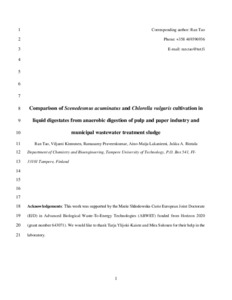Comparison of Scenedesmus acuminatus and Chlorella vulgaris cultivation in liquid digestates from anaerobic digestion of pulp and paper industry and municipal wastewater treatment sludge
Tao, Ran; Kinnunen, Viljami; Praveenkumar, Ramasamy; Lakaniemi, Aino-Maija; Rintala, Jukka A. (2017-12)
Tao, Ran
Kinnunen, Viljami
Praveenkumar, Ramasamy
Lakaniemi, Aino-Maija
Rintala, Jukka A.
12 / 2017
Julkaisun pysyvä osoite on
https://urn.fi/URN:NBN:fi:tty-201812052815
https://urn.fi/URN:NBN:fi:tty-201812052815
Kuvaus
Peer reviewed
Tiivistelmä
Two microalgae, Chlorella vulgaris and Scenedesmus acuminatus, were batch cultivated separately in two types of diluted liquid digestates. The first digestate (ADPP) was obtained from a mesophilic laboratory digester treating biosludge from a pulp and paper industry wastewater treatment plant. The second digestate (ADMW) was collected from a full-scale mesophilic anaerobic digester treating-mixed municipal wastewater treatment sludge. The highest biomass production (as volatile suspended solids, VSS), 8.2–9.4 g L−1, was obtained with S. acuminatus in ADPP. C. vulgaris in ADMW had the lowest biomass production, reaching 2.0 g L−1. Both microalgae removed ammonium efficiently from ADPP (99.9% removal) while the final ammonium removal efficiencies from ADMW with S. acuminatus and C. vulgaris were only 44.0 and 23.8%, respectively. The phosphate removal efficiencies from both ADPP and ADMW were higher than 96.9% with both microalgae. The highest carbohydrate content (60.5%) was obtained with S. acuminatus cultivated in ADPP. Scenedesmus acuminatus in ADPP showed one of the highest biomass production yields that have been reported for microalgae in real wastewater-derived nutrient sources. Consequently, this combination is promising for developing biorefinery and biofuel applications in the pulp and paper industry.
Kokoelmat
- TUNICRIS-julkaisut [16929]
